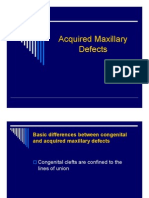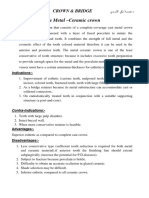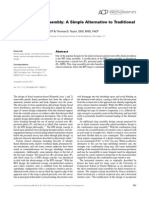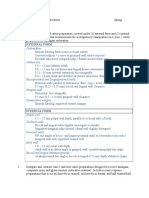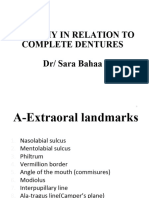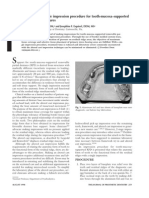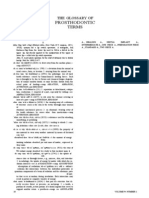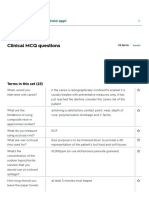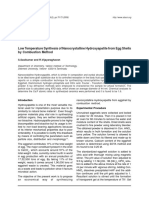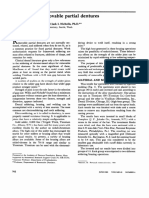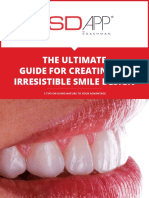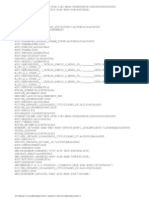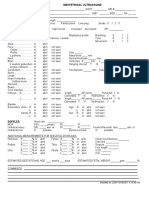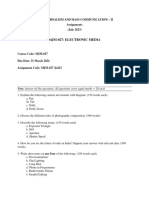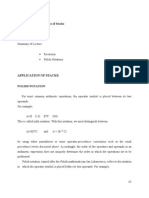Full Metal Crown Prep
Full Metal Crown Prep
Uploaded by
Jon BarnesCopyright:
Available Formats
Full Metal Crown Prep
Full Metal Crown Prep
Uploaded by
Jon BarnesCopyright
Available Formats
Share this document
Did you find this document useful?
Is this content inappropriate?
Copyright:
Available Formats
Full Metal Crown Prep
Full Metal Crown Prep
Uploaded by
Jon BarnesCopyright:
Available Formats
FULL VENEER CROWN PREPARATION
That which is finished today has little inherent value, only over time will it become invaluable as a work of art.
FULL METAL CROWN
OCCLUSAL REDUCTION
Planar reduction is started using a medium coarse tapered round ended diamond (6856-016)
Objective is to achieve reduction of the occlusal contours producing planar surfaces
FULL METAL CROWN
OCCLUSAL REDUCTION
Make depth orientation grooves on each triangular ridge and each primary developmental groove on facial and lingual inclines
FULL METAL CROWN
OCCLUSAL REDUCTION
Depth orientation grooves on facial cusps are initially placed at 1.2 mm (functional cusp)
Reduction of lingual cusps to 0.8 mm (non-functional cusp)
FULL METAL CROWN
OCCLUSAL REDUCTION
Comparing the depth groove to the measured diameter of the diamond bur as a gauge
Also a 1.0 mm or 1.5 mm enamel chisel can be used to judge depth of depth orientation grooves
FULL METAL CROWN
OCCLUSAL REDUCTION
Occlusal reduction generally establishes the planes while initiating reduction
Final refinement of occlusal reduction will be done with final finish
FULL METAL CROWN
OCCLUSAL REDUCTION
facial
Check occlusal clearance with strip of red rope wax and compare translucency of imprints of cusps-look for areas that are too thin - the handle helps orient wax bite
FULL METAL CROWN
FUNCTIONAL CUSP BEVEL
Placed with medium coarse round ended tapered diamond (6856-016)
FULL METAL CROWN
FUNCTIONAL CUSP BEVEL
Place depth reduction grooves at 1.2 mm on functional cusp, tapering gingivally to no reduction at the junction of the upper 1/3 of facial cusp
FULL METAL CROWN
FUNCTIONAL CUSP BEVEL
Chisel can help to determine if the amount of reduction is close to 1.2 mm paralleling the angle of the opposing occlusal cusp incline
FULL METAL CROWN
FACIAL & LINGUAL AXIAL REDUCTION
Use medium coarse tapered torpedo-ended diamond (6877K-014) bur
Produces a distinct crisp chamfer finish line
FULL METAL CROWN
AXIAL REDUCTION
Facial reduction maintained vertical without over-tapering
Lingual reduction the bur is kept vertical without overtapering and still creating a definite chamfer
FULL METAL CROWN
AXIAL REDUCTION
Facial and lingual reductions are carried into the proximal with out damaging adjacent teeth to create an island of tooth structure between each adjacent tooth
FULL METAL CROWN
PROXIMAL REDUCTION
Needle Flame Chamfer
Initial prep is started with with medium coarse needle diamond (852-012) Second part with medium coarse flame diamond (862-010) and fine flame diamond (8862-010) Last with medium coarse tapered torpedo-ended diamond (6877K-014)
FULL METAL CROWN
PROXIMAL REDUCTION
Initial prep with medium coarse needle diamond (852-012) moved in up and down sawing motion until the contact is opened
Objective is to open the mesial and distal enough to be able move to the medium coarse flame diamond (862-010)
FULL METAL CROWN
PROXIMAL REDUCTION
Second step is to open space with tapered medium coarse flame diamond (862-010) and fine flame diamond (8862-010) to begin to form the chamfer line
Initial preparation with medium coarse needle diamond (852-012) will partially open the contact, but not allow the medium coarse round ended diamond (6877K-014) to fit
FULL METAL CROWN
PROXIMAL REDUCTION
Lastly use the medium coarse tapered round ended diamond (6877K-014) to refine the finish line
The chamfer finish line is refined at 0.5 mm above the gingival crest in the proximal on mesial and distal surfaces
FULL METAL CROWN
PROXIMAL REDUCTIONS
Common error made is to produce a scallop at each line angle where the diamond is not brought completely through at the same level
Using a periodontal probe check the draw path between facial and lingual axial reductions
FULL METAL CROWN
Final Finishing
Use ne round ended tapered diamond (8856-016) to go over the occlusal surfaces Remember when finish lines that are cut with medium or coarse grit diamonds always need smoothing with fine grit diamond They retain enough microscopic roughness to help to retain the restoration, yet appear smooth visually
FULL METAL CROWN
Final Finishing
Use ne tapered round ended diamond (8856-016) to go over the occlusal surfaces to rene planar shape Final depth of reduction should be dened at this point to 1.0 mm on lingual non-functional cusp and 1.5 mm on facial functional cusp
10
FULL METAL CROWN
Final Finishing
Use ne tapered round ended diamond (8856-016) to go over the functional cusp to smooth and nalize reduction of incline to 1.5 mm at the cusp tip
FULL METAL CROWN
Final Finishing
Use ne tapered torpedo-ended diamond (8877K-014) to smooth and dene nal chamfer nish line on facial
11
FULL METAL CROWN
Final Finishing
Use ne tapered torpedo-ended diamond (8877K-014) to smooth and rene nal chamfer nish line on lingual
Use ne tapered torpedoended diamond (8877K-014) to smooth and rene nal chamfer nish line in the proximal surfaces
FULL METAL CROWN
Final Axial Reductions
Final chamfer finish line is adjusted to the height of gingiva at 0.5 mm from the gingival crest
Final preparation axial reductions should be about 6-8 degrees of total occlusal convergence to allow for proper path of draw of restoration
12
FULL METAL CROWN
SEATING GROOVE
The initial seating groove is placed using the 169L as a guide
Place groove to full diameter of 169L carbide bur checking the draw against the mesial and distal surfaces
FULL METAL CROWN
SEATING GROOVE
Hold 169L carbide bur against the mesial and distal taper before placing the groove
Also can check vertical alignment of seating groove using a periodontal probe placed into groove compared to mesial and distal taper
13
FULL METAL CROWN
SEATING GROOVE
After 169L, groove is enlarged/adjusted following the overall draw to the full depth of 171 carbide bur
Groove should extend to 0.5 mm above chamfer finish line and a definite gingival seat created
FULL METAL CROWN
The Final Preparation
All line and point angles should be blunted
14
FULL METAL CROWN
Features & Functions
Functional cusp bevel
Structural durability
Planar occlusal reduction
Structural durability
Axial Reduction
Retention and resistance
Seating groove
Retention and resistance
FULL METAL CROWN
Clinical Mandibular Full Veneer Crown
15
You might also like
- Bagration GermansDocument112 pagesBagration GermansАлександр Кабанов100% (6)
- Fixed Orthodontic Appliances: A Practical GuideFrom EverandFixed Orthodontic Appliances: A Practical GuideRating: 1 out of 5 stars1/5 (1)
- Introduction To Fixed ProsthesisDocument24 pagesIntroduction To Fixed ProsthesisAlaa MoradNo ratings yet
- Log Book NDOP-Oral Surgery Book 1BDocument22 pagesLog Book NDOP-Oral Surgery Book 1BAmira Md Ludin50% (2)
- Pin Retained RestorationDocument31 pagesPin Retained RestorationVinisha Vipin SharmaNo ratings yet
- Basic Principles of Obturator Design For Partially Edentulous Patients. Part I: ClassificationDocument4 pagesBasic Principles of Obturator Design For Partially Edentulous Patients. Part I: ClassificationArun PrasadNo ratings yet
- Fixed Pros 4 - Tooth Preparation For Complete Cast CrownDocument7 pagesFixed Pros 4 - Tooth Preparation For Complete Cast CrownWillan JumboNo ratings yet
- Arrangement of Artificial Teeth: Dr. Enas Abdul-SattarDocument50 pagesArrangement of Artificial Teeth: Dr. Enas Abdul-SattarShashank AadarshNo ratings yet
- Prosthodontics VivaDocument42 pagesProsthodontics VivaambiliNo ratings yet
- Partial Denture PresentationDocument39 pagesPartial Denture PresentationIbrahim Ramadan Eltorky100% (2)
- Acqiured Maxillary Defects (Compatibility Mode)Document45 pagesAcqiured Maxillary Defects (Compatibility Mode)Vero AngelNo ratings yet
- Complete Dentures: Establishing and Maintaining Mandibular Equilibration With Complete DenturesDocument6 pagesComplete Dentures: Establishing and Maintaining Mandibular Equilibration With Complete DenturesAmar Bhochhibhoya100% (1)
- Mouth Preparation and Master Cast in Removable PartialDocument45 pagesMouth Preparation and Master Cast in Removable PartialSrishti SrivastavaNo ratings yet
- ArticulatorsDocument47 pagesArticulatorshamad_kayani_774954100% (1)
- Metal Ceramic CrownDocument6 pagesMetal Ceramic CrownAsher Rizvi100% (1)
- Failures of AmalgamDocument14 pagesFailures of AmalgamPriyaancaHaarshNo ratings yet
- Failures in FPDDocument57 pagesFailures in FPDEazhil RajNo ratings yet
- Lecture 5 3rd Class PDFDocument6 pagesLecture 5 3rd Class PDFBrandon AviciiNo ratings yet
- Rests and Rest Seats: 3Rd Grade LEC. 9Document11 pagesRests and Rest Seats: 3Rd Grade LEC. 9Akanksha MahajanNo ratings yet
- RPH Clasp Assembly - A Simple Alternative To Traditional DesignsDocument3 pagesRPH Clasp Assembly - A Simple Alternative To Traditional DesignsFaheemuddin Muhammad0% (1)
- 5 RsDocument44 pages5 RssehrishNo ratings yet
- Dynamic Nature of Lower Denture SpaceDocument47 pagesDynamic Nature of Lower Denture SpacedrsanketcNo ratings yet
- A Finite Element Analysis of Ferrule Design PDFDocument10 pagesA Finite Element Analysis of Ferrule Design PDFRamona MateiNo ratings yet
- Intro To RPDDocument68 pagesIntro To RPDJamesJakeNo ratings yet
- Crown & Bridge or Fixed Prosthodontics Lectures - Level - 3Document4 pagesCrown & Bridge or Fixed Prosthodontics Lectures - Level - 3ruchikaNo ratings yet
- Study Questions DirectDocument14 pagesStudy Questions DirectagentunknownNo ratings yet
- The Complete Cast Crown Preparation: AdvantagesDocument14 pagesThe Complete Cast Crown Preparation: AdvantagesMihaela BejanNo ratings yet
- Principles of Cavity PreparationDocument99 pagesPrinciples of Cavity PreparationAME DENTAL COLLEGE RAICHUR, KARNATAKANo ratings yet
- Complex RestorationDocument59 pagesComplex Restorationsamar yousif mohamed100% (1)
- Lec 15 Arrangement of Posterior TeethDocument5 pagesLec 15 Arrangement of Posterior TeethDr.Maher MohammedNo ratings yet
- Garmy BrochureDocument36 pagesGarmy Brochuremagmuthu.980% (1)
- Extraoral M Maxillary Supporting LandmarksDocument35 pagesExtraoral M Maxillary Supporting Landmarksahmedfawakh0No ratings yet
- Silicone Impression Materials and Latex Gloves. Is Interaction Fact or FallacyDocument4 pagesSilicone Impression Materials and Latex Gloves. Is Interaction Fact or FallacyBakr Ahmed100% (1)
- Preventive Orthodontics / Orthodontic Courses by Indian Dental AcademyDocument15 pagesPreventive Orthodontics / Orthodontic Courses by Indian Dental Academyindian dental academyNo ratings yet
- Selective-Pressure Single Impression Procedure For Tooth-Mucosa-supported Removable Partial DenturesDocument3 pagesSelective-Pressure Single Impression Procedure For Tooth-Mucosa-supported Removable Partial DenturesKarthikmds Elangovan0% (1)
- ACP Complete EdentulismDocument89 pagesACP Complete EdentulismAshwin PangiNo ratings yet
- Prostho (Compelte Denture) FINAL ANSWERSDocument95 pagesProstho (Compelte Denture) FINAL ANSWERSahead1234No ratings yet
- Managing A Patient Having Bell's Palsy in ProsthodonticsDocument12 pagesManaging A Patient Having Bell's Palsy in ProsthodonticsSara Sajjad100% (2)
- Prosthodontic Terms: The Glossary ofDocument156 pagesProsthodontic Terms: The Glossary ofJishad KvNo ratings yet
- Relining and Rebasing of Complete DentureDocument7 pagesRelining and Rebasing of Complete DentureAdinda YokoNo ratings yet
- BDJ Volume 201 Issue 6 2006 (Doi 10.1038/sj - bdj.4814041) Chee, W Jivraj, S - Treatment Planning of The Edentulous MandibleDocument9 pagesBDJ Volume 201 Issue 6 2006 (Doi 10.1038/sj - bdj.4814041) Chee, W Jivraj, S - Treatment Planning of The Edentulous MandibleahmadNo ratings yet
- Marginal Configurations in FPDDocument37 pagesMarginal Configurations in FPDSonila JosephNo ratings yet
- 6.rpa Clasp DesignDocument3 pages6.rpa Clasp DesignbarbieNo ratings yet
- Clinical MCQ Questions Flashcards - Quizlet PDFDocument5 pagesClinical MCQ Questions Flashcards - Quizlet PDFed alkholidyNo ratings yet
- Nanocrystallinae Hap From Egg ShellDocument4 pagesNanocrystallinae Hap From Egg Shellcollin samuelNo ratings yet
- Emergency Drugs in Dental PracticeDocument3 pagesEmergency Drugs in Dental PracticeRishwan Omer SalihNo ratings yet
- Lec 4 Prosthodontics PDFDocument7 pagesLec 4 Prosthodontics PDFmustafa7calligrapherNo ratings yet
- Record BlocksDocument59 pagesRecord BlocksahmedNo ratings yet
- Retainers: Componet of Bridge or Fixed Partial DentureDocument12 pagesRetainers: Componet of Bridge or Fixed Partial DentureM.R PsychopathNo ratings yet
- Pecial Tray and Final Impression: Special Tray (Individual or Custom TrayDocument7 pagesPecial Tray and Final Impression: Special Tray (Individual or Custom TrayAatekaNo ratings yet
- Soldering in RPDDocument4 pagesSoldering in RPDPraveen KumarNo ratings yet
- Comparison of HorizontalDocument4 pagesComparison of HorizontalМартин АрабаджиевNo ratings yet
- C&B 12 RBBDocument89 pagesC&B 12 RBBNam BuiNo ratings yet
- Rest and Rest SeatDocument27 pagesRest and Rest SeatKreeti MishraNo ratings yet
- Smile Design GuideDocument13 pagesSmile Design Guideartwrk80No ratings yet
- FTHHHDocument17 pagesFTHHHSaad khanNo ratings yet
- Single Complete DenturesDocument20 pagesSingle Complete DenturesDeepthi RajeshNo ratings yet
- Prosthodontics and Dental MaterialsDocument18 pagesProsthodontics and Dental Materialszandro cabo100% (1)
- MCQ c2 Spring1 2013Document3 pagesMCQ c2 Spring1 2013Hassan TantawyNo ratings yet
- Coc Exam 2015 For Midwifery Part 1Document24 pagesCoc Exam 2015 For Midwifery Part 1xviii zedo100% (3)
- Quiz 1 Operation ManagementDocument9 pagesQuiz 1 Operation ManagementSaja BassamNo ratings yet
- Debug 1214Document3 pagesDebug 1214Anand MishraNo ratings yet
- Template - Assignment 1 SM015 2020-2021 PDFDocument2 pagesTemplate - Assignment 1 SM015 2020-2021 PDFKKNo ratings yet
- HuiDocument5 pagesHuiShiv SinghNo ratings yet
- Electrical Physics: Behaviour of Charged ParticlesDocument9 pagesElectrical Physics: Behaviour of Charged ParticlesLahiru PereraNo ratings yet
- House of Santa: Architecture CompetitionDocument10 pagesHouse of Santa: Architecture CompetitionAhmedBIowarNo ratings yet
- Global Banking Annual Review 2024Document27 pagesGlobal Banking Annual Review 2024enaiditNo ratings yet
- Industry Gap Valuation What-If Analysis (Power of One)Document12 pagesIndustry Gap Valuation What-If Analysis (Power of One)Pooja Smita NarjareeNo ratings yet
- Plant-DSG Papers Pvt. Ltd. PatialaDocument5 pagesPlant-DSG Papers Pvt. Ltd. PatialaRishabh GoyalNo ratings yet
- WET PCB Fabrication ProcessDocument14 pagesWET PCB Fabrication Processwebip33713100% (1)
- Laney LH 50 ManualDocument20 pagesLaney LH 50 ManualNando BonfimNo ratings yet
- Ethics Teacher GuideDocument14 pagesEthics Teacher Guidekerrin galvezNo ratings yet
- OB Ultrasound Report Template 2Document1 pageOB Ultrasound Report Template 2PriyankaNo ratings yet
- Choosing A Research TopicDocument13 pagesChoosing A Research TopicDanna Garbida100% (1)
- Astm C128Document23 pagesAstm C128LC LeeNo ratings yet
- QaswaDocument1 pageQaswaatifah3322No ratings yet
- Activity 1 - On Communication PrinciplesDocument1 pageActivity 1 - On Communication Principlesjasron09ryNo ratings yet
- Mvaj101 - Trip RelayDocument2 pagesMvaj101 - Trip Relayratheeshkumard100% (1)
- ADASDocument20 pagesADASAkshay MaheshwariNo ratings yet
- MJM 27 - July 23Document8 pagesMJM 27 - July 23mohnish aryanNo ratings yet
- 8044 eDocument6 pages8044 ePreet ShahNo ratings yet
- Common Mistakes CompilationDocument9 pagesCommon Mistakes CompilationAdamNo ratings yet
- The 14th USCTA Annual Report 2011Document59 pagesThe 14th USCTA Annual Report 2011s.sabapathyNo ratings yet
- Postfix To InfixDocument10 pagesPostfix To Infixapi-26849388100% (1)
- STRICTLY PRIVATE and CONFIDENTIAL ChiefDocument56 pagesSTRICTLY PRIVATE and CONFIDENTIAL ChiefFaidz FuadNo ratings yet
- Library Manager 1 Steinberg Library Manager enDocument9 pagesLibrary Manager 1 Steinberg Library Manager enCarolina HoyosNo ratings yet
- Wind Power Generation 123Document15 pagesWind Power Generation 123Bharat Muchhar100% (1)
- How To Trade in Secondary Oil MarketDocument84 pagesHow To Trade in Secondary Oil MarketVicente GilibertiNo ratings yet











